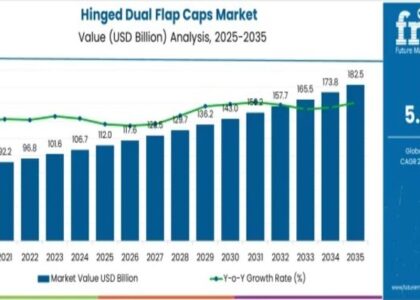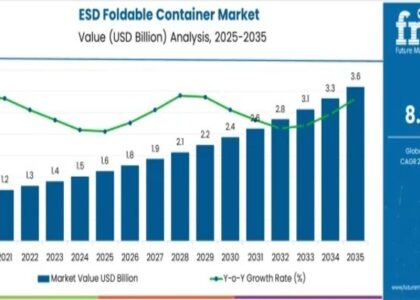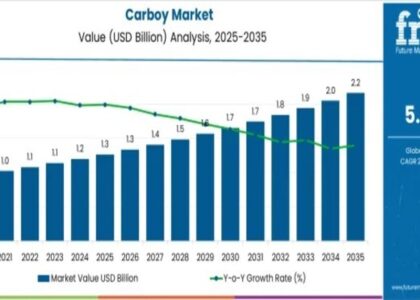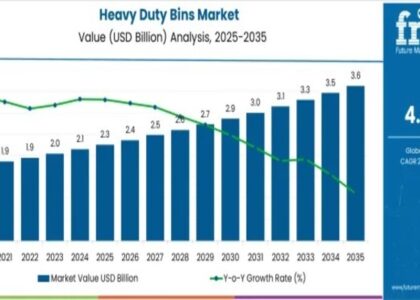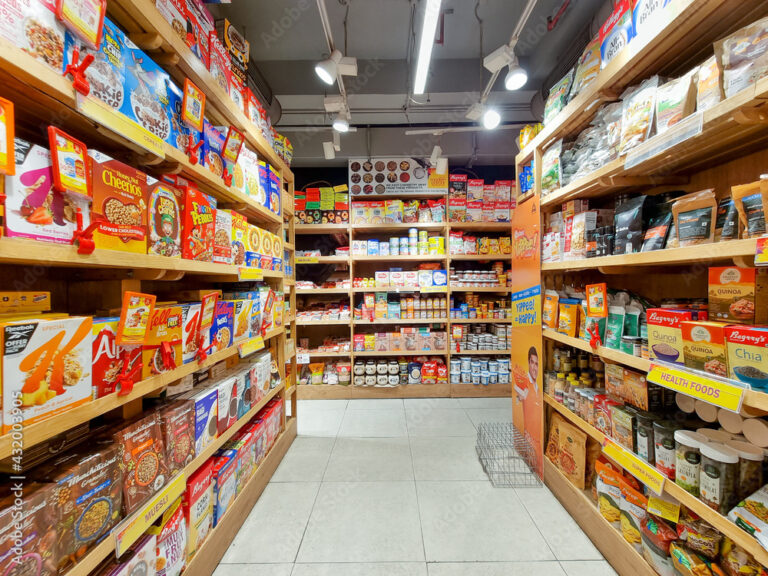
Throughout the forecast period, the Fast Moving Consumer Goods (FMCG) packaging market is projected to experience substantial growth, with an average Compound Annual Growth Rate (CAGR) of 5.8%. By 2023, the market revenue is expected to reach US$ 443.1 billion, a figure that is poised to escalate significantly, surpassing US$ 778.7 billion by 2033. This upward trajectory is indicative of the expanding consumer goods industry, driven by factors such as increasing urbanization, changing consumer lifestyles, and growing disposable incomes. The FMCG packaging sector plays a crucial role in meeting evolving consumer demands and ensuring product safety and appeal.
The upswing in both production and consumption within the pharmaceutical and food and beverage sectors is fueling heightened sales in the Indian market. Substantial investments in the food processing, personal care, and pharmaceutical industries are facilitating the robust expansion of the Fast-Moving Consumer Goods (FMCG) packaging market in India. Projections indicate India’s flourishing market, positioned at a noteworthy Compound Annual Growth Rate (CAGR) of 7.4%, outpacing other nations in the Asia Pacific region, underscoring the country’s pivotal role in shaping the regional dynamics of the FMCG packaging industry.
Request Sample: https://www.futuremarketinsights.com/reports/sample/rep-gb-110
- The restoration of the FMCG industry, rising awareness among end users around climate change, and high-end research and development facilities are fueling the market growth. Furthermore, the higher adoption of intelligent packaging in brands is also flourishing the market growth.
- The expansion of e-commerce platforms, increased focus on sustainable packaging, and rising per capita incomes are positively impacting FMCG packaging. Alongside this, the increasing penetration of online food delivery platforms is also garnering market growth.
- The increased focus on hygiene and cleanliness post-pandemic has pushed FMCG vendors to adopt multi-layer packaging solutions. The increased government efforts to transition the packaging sector and limit the carbon footprint is expected to propel the market’s growth trajectory.
- The recycled and renewable packaging solutions along with the higher sales of non-alcoholic and dairy products are likely to fuel the market. Furthermore, the usage of insulated layers in FMCG packaging is anticipated to transform the market during the forecast period.
Business Growth Drivers:
- Innovation in Packaging: Continuous innovation in packaging materials, designs, and functionalities drive consumer interest and satisfaction. Advancements such as eco-friendly materials, smart packaging with interactive features, and convenience-focused designs contribute to market growth.
- Brand Identity and Differentiation: Packaging serves as a vital tool for brand differentiation and communication. Companies invest in unique packaging designs and branding strategies to stand out on the shelves, attract consumers, and build brand loyalty.
- Consumer Convenience: Convenience-oriented packaging solutions, such as single-serve packs, resealable pouches, and easy-to-use dispensers, cater to consumers’ busy lifestyles and preferences for on-the-go consumption, driving sales.
- Sustainability Initiatives: Increasing consumer awareness and regulatory pressures regarding environmental concerns propel the demand for sustainable packaging solutions. Companies adopting eco-friendly materials and reducing packaging waste gain competitive advantages and appeal to environmentally-conscious consumers.
- E-commerce Expansion: The growth of e-commerce channels necessitates robust packaging solutions that ensure product safety during transit, minimize damage, and enhance the unboxing experience. FMCG companies invest in e-commerce-friendly packaging designs to capitalize on online retail opportunities.
- Health and Safety Concerns: Enhanced packaging functionalities, such as tamper-evident seals, hygiene barriers, and portion control features, address consumers’ health and safety concerns, contributing to market growth, especially in the food and pharmaceutical sectors.
Industry Restraints:
- Cost Pressures: FMCG companies face constant pressure to minimize packaging costs while maintaining quality and functionality. Fluctuations in raw material prices, transportation costs, and regulatory compliance expenses can strain profit margins.
- Regulatory Compliance: Compliance with stringent regulations governing packaging materials, labeling requirements, and sustainability standards adds complexity and costs to FMCG packaging operations. Non-compliance risks legal penalties and reputational damage.
- Environmental Concerns: While sustainability initiatives drive innovation, transitioning to eco-friendly packaging materials and practices may entail higher upfront costs and technical challenges. Limited availability of sustainable alternatives and infrastructure for recycling and composting also pose constraints.
- Supply Chain Disruptions: Disruptions in the supply chain, such as raw material shortages, transportation bottlenecks, and geopolitical uncertainties, can impact packaging production and distribution, leading to delays and increased costs.
- Competitive Pressures: Intense competition within the FMCG sector necessitates continuous investment in packaging innovation and branding to maintain market share. Rapid changes in consumer preferences and disruptive market entrants pose challenges for established players.
- Changing Consumer Preferences: Shifting consumer preferences towards minimalistic packaging, natural ingredients, and personalized experiences require FMCG companies to adapt their packaging strategies accordingly, which may entail significant investments and restructuring.
Key Points
- The United States market leads the FMCG packaging market in terms of market share in North America. The United States region held a market share of 18.9% in 2022. The growth in this region is owing to the restored FMCG product line, and higher consumption of ready-to-eat food items. The North American region held a share of 28.5% in 2022.
- Germany’s FMCG packaging market is another significant market in the European region. The market held a market share of 7.1% in 2022. The growth is attributed to higher government efforts and increased support for sustainable business ideas and adoption. Europe held a market share of 24.3% in 2022.
- The Indian FMCG packaging market thrives at a leading CAGR of 7.4% during the forecast period. The market’s growth is attributed to the expansion of sustainable businesses, and proliferating e-commerce penetration.
- Chinese FMCG packaging market also thrives at a CAGR of 6.0% between 2023 and 2033. The growth is attributed to the large FMCG consumer base and higher imports.
- Based on product type, the rigid packaging segment held the leading market share of 63.9% in 2022. The growth is attributed to the increased strength, durability, and recycling capabilities.
- Based on end use, food, and beverages consumed most of the market as it held a leading market share of 56.2% in 2022.
Competitive Landscape
The key vendors work on using environmentally friendly and bio-degradable materials in their solutions. Key competitors and also merge, acquire, and partner with other companies to increase their supply chain, and distribution channel.
Request Report Methodology: https://www.futuremarketinsights.com/request-report-methodology/rep-gb-110
Key Players
- Berry Global Inc.
- Crown Holdings
- WestRock Company
- Sealed Air Corporation
- Sonoco Products Company
- Ball Corporation
- Kimberly-Clark Corporation
- Mondi Plc
- Huhtamaki Oyj
- Ardagh Group S.A.
Recent Market Developments
- Sonoco Products Company has introduced material expertise and sustainable flexible packaging solutions. Some of the common packaging types that the company offers include flexible packaging, rigid paper containers, rigid plastic, and blister packaging.
- Ball Corporation has introduced the total advertising and packaging package for the end user companies of different levels.
Demand for Rigid Packaging in the Food and beverage Sector Will Remain High
In the context of end-use applications, the food and beverage sector is expected to witness a notable sales uptick, with a projected 6.1% Compound Annual Growth Rate (CAGR) throughout the forecast period. Beverage companies are actively embracing innovative packaging formats to enhance sales, with this segment commanding a substantial share of 63.9% in 2022.
Illustrating this trend, AVE United Kingdom introduced a new line of bottling equipment in August 2019, featuring Monobloc (filler/capper) and Unibloc (rinser/filler/capper) models capable of handling diverse components within a single machine. This mobile bottling equipment is strategically designed to mitigate costs associated with plastic packaging.
Buy Now/Purchase: https://www.futuremarketinsights.com/checkout/110
Key Segments Covered
By Product Type:
- Flexible Packaging
- Pouches & Sachets
- Stick Packs
- Bags & Sacks
- Foils & Films
Rigid Packaging:
- Boxes & Cartons
- Trays
- Tubes
- Containers & Jars
- Bottles
- Cans
- Blisters
By Material Type:
- Plastic
- Paper and Paperboard
- Metal
- Glass
- Others (Wood, Foam, etc.)
By End Use:
- Food & Beverage
- Pharmaceuticals
- Personal Care & Cosmetics
- Homecare Products
- Electronics
- Others (Office Supplies, Textiles, etc.)
About Future Market Insights (FMI)
Future Market Insights, Inc. (ESOMAR certified, recipient of the Stevie Award, and a member of the Greater New York Chamber of Commerce) offers profound insights into the driving factors that are boosting demand in the market. FMI stands as the leading global provider of market intelligence, advisory services, consulting, and events for the Packaging, Food and Beverage, Consumer, Technology, Healthcare, Industrial, and Chemicals markets. With a vast team of over 5000 analysts worldwide, FMI provides global, regional, and local expertise on diverse domains and industry trends across more than 110 countries.
Contact Us:
Future Market Insights Inc.
Christiana Corporate, 200 Continental Drive,
Suite 401, Newark, Delaware – 19713, USA
T: +1-845-579-5705
For Sales Enquiries: sales@futuremarketinsights.com
Website: https://www.futuremarketinsights.com
LinkedIn| Twitter| Blogs | YouTube


